Chiller types and application guide. In this article we’ll be covering the different types of chillers available, where they are used as well as the pros and cons of each chiller type along with some examples of where they’re used. We’ll be covering air cooled chillers, water cooled chillers, centrifugal compressor chillers, turbocor compressor chillers, screw compressor chiller, scroll compressor chiller, reciprocating compressor chillers. Scroll to the bottom of the article to watch the video tutorial
If you’re interested in chiller technology then you should checkout the wide range of Danfoss chiller solutions at Chillers.Danfoss.com Danfoss has a wide portfolio of products to help all types of chiller systems perform reliably and efficiently. Their products include compressors, AC drives, system protectors, heat exchangers, valves, electronics, and sensors. They’re committed to helping you build better chillers — from the inside out. Learn more at Chiller.Danfoss.com

Just to recap on your previous knowledge of chillers. Chillers are simply machines used to generate cold or chilled water which is distributed around buildings to provide air conditioning. They are also used in some industrial processes but we’re going to primarily focus on their application in air conditioning of buildings typically with Air Handling Units and Fan Coil Units
As you can imagine there are a lot of different types of chillers and they are categorised by types, so its important you understand what the names mean, the differences between them and when and where they are used as well as why.
The first way to categorise a chiller is by defining whether it is a vapor compression or vapor absorption type chiller.
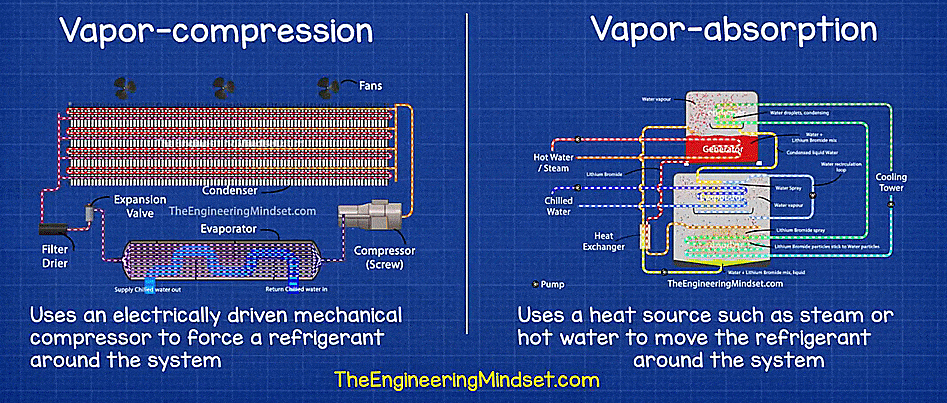
Vapour compression chillers and Vapor absorption chillers
Vapour compression chillers use an electrically driven mechanical compressor to force a refrigerant around the system. These are the most common types of chillers. There are two sub categories for vapor compression chillers which are water cooled or air-cooled chillers and we’ll look at these shortly.
Vapor absorption chillers will use a heat source to move the refrigerant around the system rather than using a mechanical compressor. The refrigerant in these chillers move around between areas of different temperature and pressure. Click here to watch the video tutorial on these chillers.
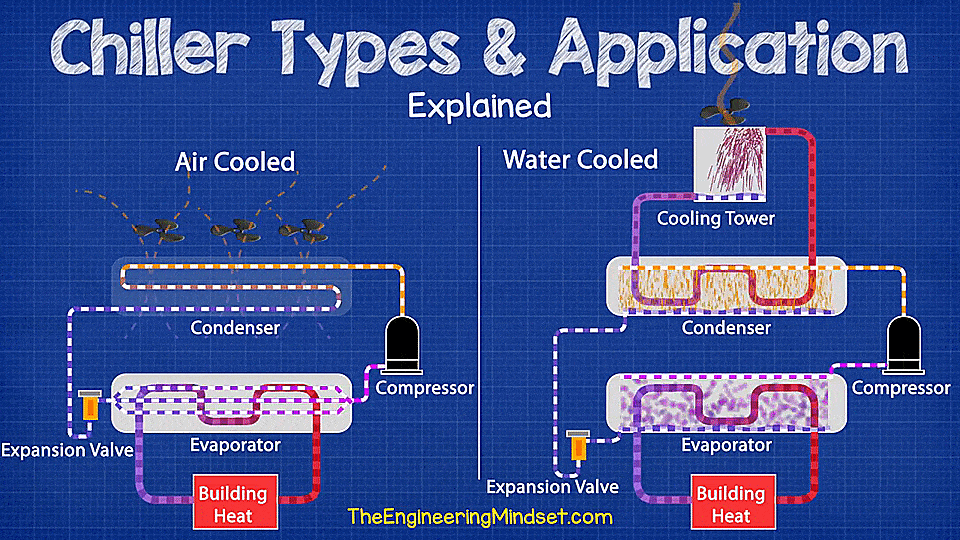
Looking at vapor compression chillers, the two main types are air cooled and water cooled. Both types of chillers have the same essential components which are, the evaporator, the compressor, the condenser and the expansion valve. When we talk about air cooled or water cooled this simply refers to the way in which the unwanted heat is ejected from the building via the chillers condenser.
The working principle for both air cooled and water cooled chillers is the same. A compressor pushes a refrigerant round the inside of the chiller between the condenser, expansion valve, evaporator and back to the compressor. The only difference is that with an air cooled chiller, fans force air across the exposed tubes of the condenser which carry the heat away. Water cooled chillers have a sealed condenser and water is pumped through to take the heat away and disperse this through the cooling tower. The cooling tower will also use a fan to reject the heat. Watch the video tutorial on how cooling towers work here
Where are these chillers typically used? – chiller types and application guide

Large buildings with cooling loads in excess of 400 tons of refrigeration or 1,400 kW typically use water cooled chillers with either centrifugal compressors or Turbocor compressors within the central plant cooling system. They might also use a separate smaller air cooled chiller to handle the critical cooling loads such as computer and communication rooms. There might also be an absorption chiller within the central plant system, making use of waste heat, for example from a CHP engine, but these are mostly used alongside mechanical chillers.
Medium sized buildings with a cooling load of around 200 – 400 tons of refrigeration or 700 – 1,400 kW will typically use screw compressors or Turbocor compressors, these can be either water or air cooled, we’ll look at why that would be just shortly. These buildings might also use an absorption chiller if enough high quality heat is available
Small building with cooling loads under 200 tons or 700 kW will typically use scroll compressors or Turbocor compressors and are typically of air cooled design. Again we’ll look at why just shortly, they might also use a different system such as VRF units but this depends on the size of the building and the cooling load.
Absorption chillers should only be used where there is an abundance of high quality waste heat or cheap heat. They are often found in hospitals and buildings with heated swimming pools. If a commercial office type building uses a combined heat and power (CHP) engine these are often coupled with an absorption chiller which uses the waste heat from the combustion, but in this scenario these are mostly used in conjunction with electrically driven chillers. Sometimes they are used during times of day when electricity prices peak.
If you have a building with a medium to large cooling load then its recommended that you do not use only one oversized chiller to handle the entire cooling load. This is not efficient and if it fails you will have no cooling capability left.
Instead you should use multiple chillers, in parallel, of different sizes to meet the changing seasonal load at optimal performance with redundancy built in. For example you have a building with a cooling load of 2,200 Tons, then you should use combinations such as two 1,200 ton chillers or two 900 tones and a 500 ton or a 1,000 ton and two 700 ton chillers etc. The configuration options are almost limitless.
You also need to consider the criticality of the building and the redundancy required, known as N+1, where by “N” is the number of chillers you need and the “+1” or “+2” or “+3” etc is the number of backup chillers needed to continue to meet cooling capacity in the event of a failure.
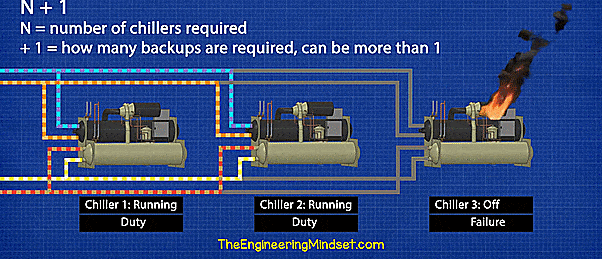
This is used so that if a chiller fails you have a backup always ready to come online to take over and handle the cooling load. You might need to use chillers with multiple compressors that can work independently from one another so that if 1 compressor fails the chiller can still remain partly operational.
How to decide between air cooled and water cooled – Chiller types and application guide
Water cooled chillers.
Pros
- Water cooled chillers are more efficient, especially for large cooling loads, they use the evaporation of water to dissipate heat which is less energy intensive than blowing air across a hot surface like air cooled chillers. Water also has a higher heat capacity than air so its inherently easier to remove the heat
- Water cooled chillers can handle larger loads, for their floor space, compared to air cooled.
- Water cooled chillers generally last longer because they are inside the building so deteriorate much slower
Cons
- These use cooling towers and for this you need access to a constant clean water supply. If the chiller is going to be installed in an area with water restrictions then you don’t want this type.
- Water cooled chillers are located within the building and are very large machines, so depending on the compressor technology used, they can create a lot of noise and vibration inside the building which is why they are usually located in the basement.
- Water cooled chillers cost more to install and maintain
- Water cooled chillers take up space within the building, they need mechanical plant rooms, more risers, more pumps, cooling towers and water treatment, this space therefore can’t be used for business purposes.
Air cooled chillers.
Pros
- Air cooled chillers cost less to install because they have less equipment.
- Air cooled chillers require less space, they can sit on the roof and do not need a mechanical room. This means more space within the building for business purposes.
- Air cooled chillers require less maintenance compared to water cooled chillers, again because they have less equipment
- Air cooled chiller systems are much simpler design and do not need another set of pumps for the condenser
Cons
- Air cooled chillers sit outside the building, their fans and compressors will create noise which the surrounding areas might be able to hear, although some measures can be implemented to reduce this
- Air cooled chillers typically do not have as long a service life as water cooled chillers because they are exposed to the sun, rain, frost, snow and wind which deteriorate the materials.
- Air cooled chillers can suffer from damage, blockages and re-circulation issues.
Unfortunately many building owners want the cheapest upfront option, but this is a bad idea because for a little extra they could have bought a more efficient chiller which will be cheaper to operate especially as chillers can last for around 15 – 25+ years in operation, so it will have paid for itself multiple times and would have resulted in reduced environmental emissions.
The different compressor technologies currently available – Chiller types and application guide
Centrifugal chillers
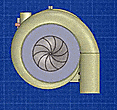
- Water cooled chillers
- used in medium to large cooling loads
- Typically, available in 150 – 6,000 TR, 530 – 21,000 kW
- Water cooled COP of between 5.8 to 7.1
- Typically use only one compressor sometimes two for exceptionally large capacity
- Work best at full loading, VFD can e fitted to improve part load
- Use one or two rotating impellors to compress the refrigerant and force it around the chiller
- Capacity control through speed control and vane guides
Turbocor chillers

- Air or water-cooled chillers
- Used in all cooling loads from large to small buildings
- Typically, available in 60 – 1500 TR, 210 – 5,200 kW
- COP of 4.6 up to 10
- One or more compressors used, staged and speed varied
- Variable speed controller, soft starter, magnetic bearings, only one moving part, oil free
- Use two rotating impellors to compress the refrigerant
- Capacity control through speed control and vane guides
Reciprocating chillers
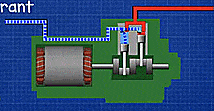
- Air or water cooled chillers – old technology, less common now
- Used in small to medium cooling loads – common in simple low-cost refrigerators
- Typically available in 50 – 500 TR, 170 – 1,700 kW
- COP of 4.2 to 5.5
- Use a piston and chamber to compress refrigerant
- Capacity control through compressor staging or cylinder unloading and speed control
Scroll chiller

- Air or water-cooled chillers
- Used in small to medium cooling loads
- Typically, available 40 – 400 TR, 140 – 1,400 kW
- Air cooled COP 3.2 – 4.86 Water cooled COP 4.45 – 6.2
- One or more compressors, fixed or variable speed, staged or speed controlled
- Use two spiral plates to compress the refrigerant, one fixed in place, one rotates.
- Capacity controlled via momentarily separating scrolls with solenoid valve and electronic modulation
Screw chiller
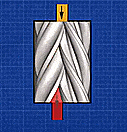
- Air or water-cooled chillers
- Used in small to medium cooling loads
- Typically, 70 – 600 TR, 250 – 2,100 kW
- Air cooled COP 2.9 – 4.15 Water cooled COP: 4.7 – 6.07
- Typically, 1 compressor on water cooled, 1 or 2 compressors on air cooled
- Uses two interlocking rotating helical rotors to compress the refrigerant, capacity is controlled via speed control or slider
Absorption chillers

- Use heat to drive the refrigeration process, usually steam or hot water
- Used in Medium to large buildings, Hospitals, Swimming centres, Heat Networks
- Typically, 70 – 1,400 TR, 250 – 4,900 kW
- COP of approx. 0.6 to 1.9
- No compressor, direct or indirect fired. Capacity controlled via amount of heat entering
- Idea for using waste heat or cheap heat, sometimes used to offset peak electricity costs
- Typically combined with mechanical chillers

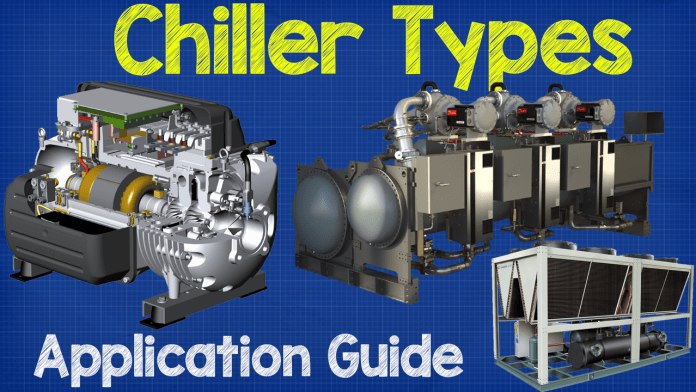
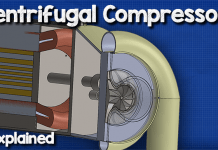
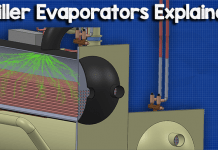
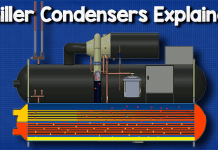
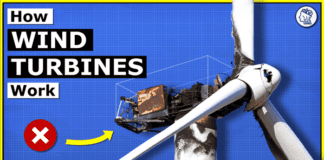
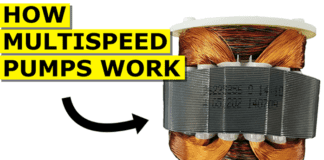
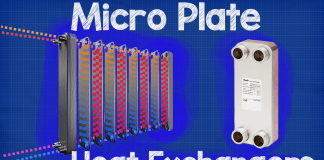


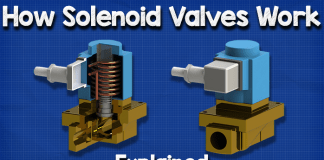








[…] is the most energy intensive part, that being the compressor. In our previous video we looked at chiller types and applications where we covered the different types of compressors, the applications and efficiency. Check that […]
Very interesting information well explained
Thank you very much .. very interesting informations
Thank you for that simple but very clear explanation.
Thank you for sharing your blog! Very informative and explanation about chiller. It is very helpful for me.
what are the differences between a refrigeration chiller and a process chiller?
A refrigeration chiller will run at lower temperatures because it serves different purposes than a process chiller. A process chiller could be used in applications where you can run at higher temperatures, for example 15 degC, such as equipment that dumps heat and needs to be water cooled. You will not want to go much colder than 14 or so degC or you may encounter condensation issues.